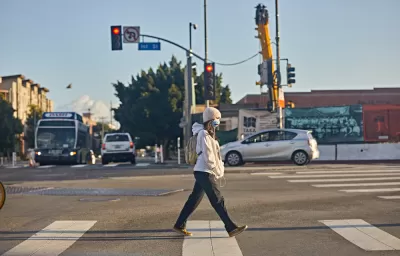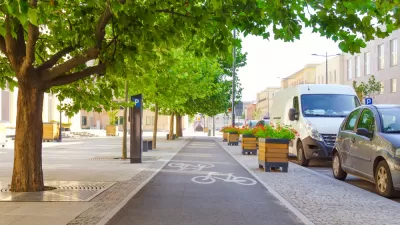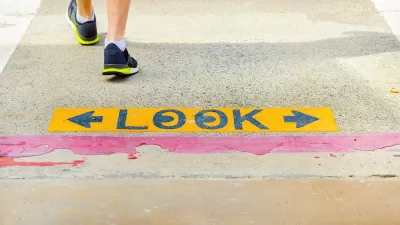The city's 2015 mobility plan was hailed as one of the nation's most ambitious, but progress toward its goals has been less than impressive.

A coalition of community groups and safe streets advocates in Los Angeles is proposing a ballot measure that would speed up the city's adoption of its own Vision Zero goals as set out in its mobility plan. As AC Schick reports for Annenberg Radio News, "This initiative would create a safer and greener city by improving public transportation, environmental standards, and protecting cyclists and pedestrians."
Per Streetsblog L.A.'s Joe Linton, "Healthy Streets L.A. would require the city to implement its own approved Mobility Plan whenever the city repaves or otherwise works on a street." Despite passing the Mobility Plan 2035 in 2015, the city has not made much progress on the plan's stated goals. According to Linton, "Mayor Eric Garcetti failed to task his transportation department with implementing approved multimodal facilities that might marginally delay drivers." Linton points out that "According to Streets For All founder Michael Schneider, L.A. has only implemented 95 miles out of 3,137 miles of Mobility Plan features – about three percent in seven years."
Schneider is quoted in the Annenberg Radio News article as saying, "If you look at the city’s high injury network, which is the six percent of streets to make up the majority of injuries and deaths in the city, the majority are in South LA, East LA, downtown and central LA. And so if we want to do a service to people in those communities stopping them from dying in the street just by trying to bike or cross the streets, the ballot measure would be a great first step."
To reach the ballot, the measure needs roughly 93,000 signatures or votes from eight city council members.
FULL STORY: Healthy Streets LA ballot measure aims to create a cleaner, greener city

Alabama: Trump Terminates Settlements for Black Communities Harmed By Raw Sewage
Trump deemed the landmark civil rights agreement “illegal DEI and environmental justice policy.”

Planetizen Federal Action Tracker
A weekly monitor of how Trump’s orders and actions are impacting planners and planning in America.

The 120 Year Old Tiny Home Villages That Sheltered San Francisco’s Earthquake Refugees
More than a century ago, San Francisco mobilized to house thousands of residents displaced by the 1906 earthquake. Could their strategy offer a model for the present?

Ken Jennings Launches Transit Web Series
The Jeopardy champ wants you to ride public transit.

BLM To Rescind Public Lands Rule
The change will downgrade conservation, once again putting federal land at risk for mining and other extractive uses.

Indy Neighborhood Group Builds Temporary Multi-Use Path
Community members, aided in part by funding from the city, repurposed a vehicle lane to create a protected bike and pedestrian path for the summer season.
Urban Design for Planners 1: Software Tools
This six-course series explores essential urban design concepts using open source software and equips planners with the tools they need to participate fully in the urban design process.
Planning for Universal Design
Learn the tools for implementing Universal Design in planning regulations.
Clanton & Associates, Inc.
Jessamine County Fiscal Court
Institute for Housing and Urban Development Studies (IHS)
City of Grandview
Harvard GSD Executive Education
Toledo-Lucas County Plan Commissions
Salt Lake City
NYU Wagner Graduate School of Public Service





























